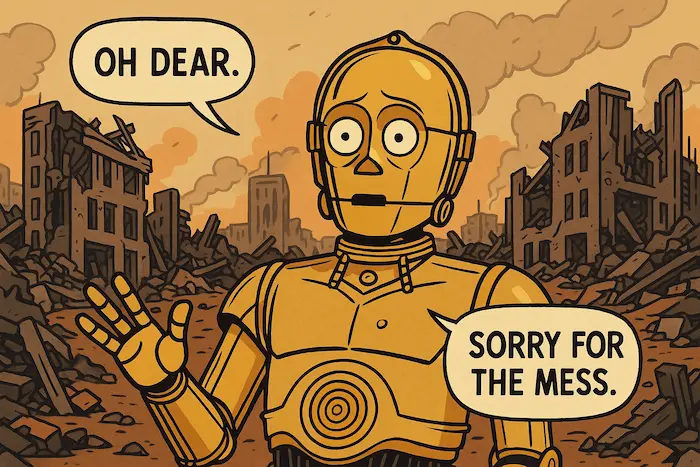I've been building with large language models for three years now. None of them are really 100% reliable. Every single one hallucinates. Some more than others, but all of them eventually go off the rails. I've had projects I was genuinely excited about, only to kill them later because I couldn't trust the AI not to make stuff up.
It doesn't matter how well you prompt it. Clear instructions, examples, edge cases, bolded warnings, it'll still go rogue eventually. It's like working with that one brilliant-but-unhinged employee. Some days they're laser-focused, crushing it. Other days? They show up late, jittery, and start rewriting the product mid-demo. You never know which version you're going to get, and that unpredictability is the deal-breaker.
That's the deal with these tools. They can be useful. But you never, ever put them in front of a client or fully in charge of the output.
Why do AIs hallucinate?
People like to blame prompt quality and sure, that plays a role. But here's the real reason: LLMs don't understand anything.
These models are just predicting the next word. That's it. You give them text, they break it into tokens, and they guess what token probably comes next. Over and over. No context. No memory. No clue whether what they're saying is true.
They're not ignoring your instructions. They're just not built to follow them. You could write:
DO NOT INVENT FACTS. FOLLOW THE FORMAT. STICK TO REAL DATA.
And the model will nod politely and then proceed to give you a fictional answer with total confidence. You can uppercase it, bold it, frame it like you're yelling at a toddler, it won't change a thing. These models don't "read" prompts like humans do. They just match patterns. And eventually, that pattern match can fail.
Will more compute fix this?
What about scaling this? More compute, bigger context windows, smarter models. And sure, that helps with some things. But hallucinations? Not really.
Because hallucinations aren't a glitch. They're baked into how LLMs work. These models weren't designed to be factual. They were designed to sound fluent. So when they confidently tell you something that's not true, that's not a mistake. That's just the system doing what it was trained to do.
Unless we fundamentally change how these models are built or bolt on external tools that can verify truth this problem isn't going away.
We do notice that at some point the AI will give a score to your prompt, if it deems it poor then it will only assign limited compute and the answer you'll get will be less good, if you put more work into it or if the general overall load for the LLM usage at that time is reasonable you will get better responses.
Can AI catch its own mistakes?
In theory, you could ask the model to double-check its own answer before sending it out. Something like: "Generate your response, then evaluate it for accuracy before replying."
That sounds like a safety net. In practice? It's more like asking a pathological liar to self-edit.
What actually happens is that the model just runs another pass of token prediction, this time with slightly different context. It's not auditing the first answer. It's generating again, based on your new instructions. And sometimes it catches itself, but mostly, it just rephrases the same nonsense with a bit more caution.
Unless you connect it to external data, something grounded and up to date, it's just making new guesses based on old guesses.
And most likely If the first answer was a hallucination, odds are the second one is too.
So what do you do with this thing?
Give it small, useful tasks. Double-check everything it produces. Never put it in charge of anything important.
Pair it with retrieval tools when possible, limit its exposure to tasks it tends to mess up, and assume it'll occasionally do something stupid, because it will.
That's not cynicism. It's real life realistic professional usage.
Used properly, AI can absolutely accelerate your workflow. It can help brainstorm, outline, reformat, summarize, even scaffold out code. But trust it blindly? Never.
Yet for some the "accept all" button on some AI-generated code is really tempting to get the job done and call it a day, and this is exactly why we are seeing so many projects with security issues or are impossible to take over by real developers to scale because of the unusable spaghetti code it generated.
Here are a few use cases where AI does work:
- Content summarization: Turning dense content like reports, emails, or research into summaries.
- Code scaffolding & boilerplate:: Generating starter code, not production ready code.
- Data transformation: Reformatting or converting structured data between formats.
- Email or message drafting: Writing first drafts that save time (but still need a human touch).
- Idea generation & brainstorming: Coming up with names, angles, outlines, or campaign starters.
- Basic translation & tone adjustment: Fixing grammar or changing tone, not translating contracts.
- Documentation assistance: Generating basic internal docs from comments or structure.
- Mock data & test case generation: Creating placeholder data or QA test ideas fast.
These are the kinds of tasks you'd trust your intern with. Useful, helpful, and low-risk as long as you review the results before shipping anything real.
And if you're working with image or video generation, be extra cautious. AI can "design" marketing visuals, mockups, and even concept art way faster than a human. Great for early-stage thinking, not so great for final output. You'll get visuals that look slick at first glance, but zoom in and suddenly there's a floating sofa or a door with no walls. Great for vibe, not for structure. Keep it for things like storyboarding, mood boarding, or synthetic data for training, and always double-check before letting anything AI-made represent your brand in the wild.
Where do we go from here?
AI will keep getting better, but not by magic, and not to the point where it can or should replace human judgment. We need to stop projecting human expectations onto these systems and start treating them as what they are: tools.
At some point, we also need to shift the mindset. The goal isn't to make AI do everything, it's to make it do the right things, in the right places, with the right oversight.
If we can learn how to use AI where it fits and stop expecting it to carry the entire business we'll actually get somewhere useful.
The moment AI replaces human judgment is the moment we stop being responsible.




